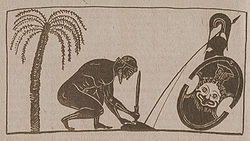Murder–suicide
| Suicide |
|---|
A murder–suicide is an act where an individual intentionally kills one or more people before killing themselves. The combination of murder and suicide can take various forms:
- Suicide after or during murder inflicted on others
- Suicide after murder to escape criminal punishment(s)
- Suicide after murder as a form of self-punishment due to guilt
- Murder that entails suicide, such as suicide bombing
- Suicide by pilot, or the deliberate crash of a vehicle carrying the perpetrator and others
- Murder of an officer or bystander during the act of suicide by cop
- Suicide before or after murder by proxy
- Murder linked with a person with suicidal ideation
- Joint suicide in the form of killing the other with consent, and then killing oneself
Suicide-lawful killing has three conceivable forms:
- To kill one's assailant through proportionate self-defense, killing oneself in the process
- Lawful killing to prevent an individual from causing harm to others, in so doing killing oneself
- Lawful killing indirectly resulting in or contributing to suicide
Many spree killings have ended in suicide, such as in several school shootings. Some cases of religiously motivated suicides may also involve murder. All categorization amounts to forming somewhat arbitrary distinctions where relating to intention in the case of psychosis, where the intention(s) is/are more likely than not to be irrational. Ascertaining the legal intention (mens rea) is inapplicable to cases properly categorized as insanity.
Some use the term murder–suicide to refer to homicide–suicide, which can include manslaughter and is therefore more encompassing.[1]
According to an analysis of the London Times' reports of murder (1887-1990) by Danson and Soothill (1996), there is a much higher proportion of British male murder-suicides, in general, than female. Overwhelmingly the women committing murder-suicide tend to kill their children and then themselves. Men, on the other hand, tend to kill their spouses or partners and then themselves.[2]
Theories
[edit]
According to psychiatrist Karl A. Menninger, murder and suicide are interchangeable acts – suicide sometimes forestalling murder, and vice versa.[3] Following Freudian logic, severe repression of natural instincts due to early childhood abuse may lead the death instinct to emerge in a twisted form. The cultural anthropologist Ernest Becker, whose theories on the human notion of death are strongly influenced by Freud, views the fear of death as a universal phenomenon, a fear repressed in the unconscious and of which people are largely unaware.
This fear can move individuals toward heroism, but also to scapegoating. Failed attempts to achieve heroism, according to this view, can lead to mental illness and/or antisocial behavior.[4]
In a study specifically related to murder–suicide, Milton Rosenbaum (1990) discovered the murder–suicide perpetrators to be vastly different from perpetrators of homicide alone. Whereas murderer–suicides were found to be highly depressed and overwhelmingly men, other murderers were not generally depressed and more likely to include women in their ranks.[4] In the U.S. the overwhelming number of cases are male-on-female.[5] Around one-third of partner homicides end in the suicide of the perpetrator.[citation needed] From national and international data and interviews with family members of murder–suicide perpetrators, the following are the key predictors of murder–suicide: a history of substance abuse, the male partner some years older than the female partner, a break-up or pending break-up, a history of battering, and suicidal contemplation by the perpetrator.[citation needed]
Though there is no national tracking system for murder–suicides in the United States, medical studies into the phenomenon estimate between 1,000 and 1,500 deaths per year in the US,[6] with the majority occurring between spouses or intimate partners and the vast majority of the perpetrators being male. Depression, marital or/and financial problems, and other problems are generally motivators.
Homicides which are later followed by suicide often make headline news; national statistics indicate 5% of all homicidal deaths are caused by murder–suicides. The U.S. Department of Health and Human Services, Centers for Disease Control reports[7] that an estimated 1 million adults reported attempting suicide in 2011, and there were over 38,000 completed suicides in the same period.[8] The estimate of 624 murder–suicide events per year[9] indicates that around 1.6% of suicides involve murder.
In 18th-century Denmark, people wishing to die by suicide would sometimes commit murder in order to receive the death penalty.[10] They believed murder followed by repentance would allow them to end their life while avoiding damnation.[10]
See also
[edit]- Crime of passion
- Mass murder
- Mass shooting
- School shooting
- Serial killer
- Spree killer
- Shinjū
- Suicide attack
- Suicide by pilot
- Kamikaze
References
[edit]- ^ Liem, Marieke (2010-05-01). "Homicide followed by suicide: A review". Aggression and Violent Behavior. 15 (3): 153–161. doi:10.1016/j.avb.2009.10.001. ISSN 1359-1789.
- ^ "Psychology of Murder Suicide". Archived from the original on 2016-03-07. Retrieved 2017-10-27.
- ^ "Karl Menninger quote".
- ^ a b Van Wormer, K.; Odiah, C. (1999). "The psychology of suicide-murder and the death penalty". Journal of Criminal Justice. 27 (4): 361–370. doi:10.1016/S0047-2352(99)00008-2.
- ^ Warren-Gordon, K.; Byers, B. D.; Brodt, S. J.; Wartak, M.; Biskupski, B. (2010). "Murder Followed by Suicide: A Newspaper Surveillance Study Using the New York Times Index". Journal of Forensic Sciences. 55 (6): 1592–1597. doi:10.1111/j.1556-4029.2010.01473.x. PMID 20533976. S2CID 205769141.
- ^ "American Roulette: Murder–Suicide in the United States. Violence Policy Center" (PDF).
- ^ "CDC Suicide, Facts At A Glance, 2012" (PDF).
- ^ "National Vital Statistics Reports Volume 61, Number 6 October 10, 2012" (PDF).
- ^ "Violence Policy Center, American Roulette, Murder-Suicide in The United States, Fourth Edition" (PDF).
- ^ a b Ebdrup, Niels (March 31, 2012). "Kill to be killed in 18th century Denmark". ScienceNordic. Past Horizons. Archived from the original on March 14, 2013. Retrieved April 1, 2012.
Further reading
[edit]- van Wormer, K.; Roberts, A. R. (2009). Death by Domestic Violence: Preventing the Murders and Murder–Suicides. Westport, CT: Praeger.


 French
French Deutsch
Deutsch